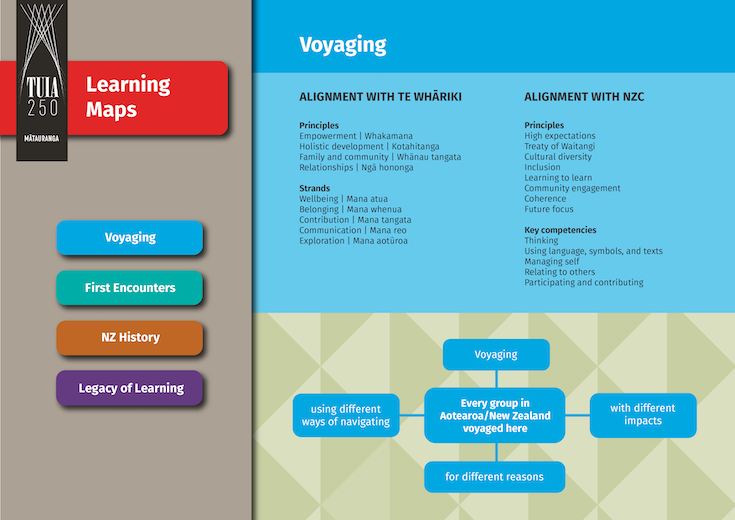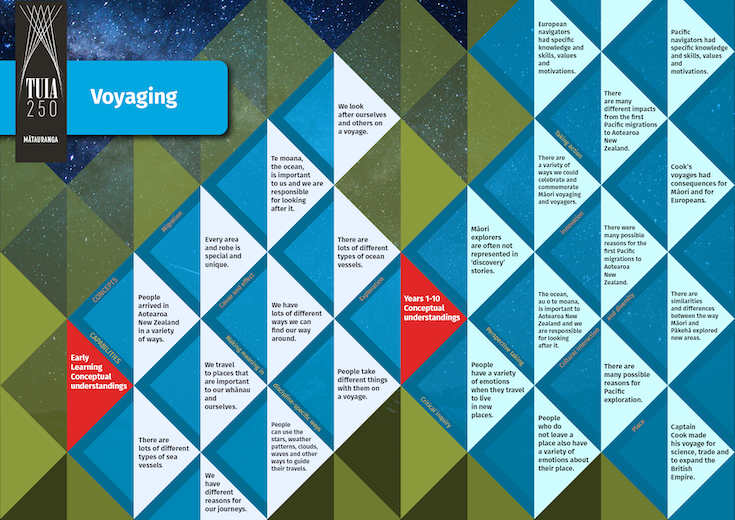Voyaging
The Tuia Mātauranga themes are designed to be taught separately and are broad enough to be taught at any time. They support robust exploration of New Zealand's histories in local contexts and have value beyond the commemorations.
This teaching and learning guide has been created for Early Learning and may also be found on Te Whariki Online.
Within this theme Voyaging you will find:
Learning map | Conceptual understandings | Inquiry questions | Teaching and Learning Guide | Video
Learning map
Download a PDF version:
Voyaging learning map.pdf 502 kB
Conceptual understandings
Download a PDF version:
Voyaging conceptual understandings.pdf 323 kB
Inquiry questions
Suggested years 1–10 inquiry questions for the Voyaging theme
- What were the reasons for the first Polynesian migrations to Aotearoa New Zealand?
- What were the consequences of the first Polynesian migrations to Aotearoa New Zealand?
- What were the reasons for the subsequent waves of Polynesian migration to Aotearoa New Zealand?
- What were the consequences of the subsequent waves of Polynesian migration to Aotearoa New Zealand?
- What were the main reasons for Captain Cook’s voyages?
- Who was positively affected by his voyages? What are the consequences of this?
- Who was negatively affected by his voyages? What are the consequences of this?
- How might it feel to leave your home to explore new areas?
- How might the ones who were left behind have felt?
- How might it have felt for Māori people who went to England?
- Think about some of the voyages away from Aotearoa New Zealand, such as Ihumātao going to the United Nations or Hongi Hika meeting Queen Victoria. How might they have felt? What prompted these voyages?
- What are some similarities and differences between the way Māori and Pākehā explored new areas?
- Read a story about Polynesian exploring – what values does it show? What perspectives might be missing?
- Read a story about European exploring – what values does it show? What perspectives might be missing?
- Have the reasons people make voyages changed over time?
- How can we look after te moana (the ocean) better?
- How does the sea influence us in Aotearoa New Zealand?
- How can we increase awareness about Māori explorers?
- How could we celebrate/and commemorate Māori voyaging and voyagers?
Download a PDF version:
Voyaging Years 1-10 inquiry questions.pdf 122 kB
Teaching and Learning Guide
Download the Voyaging Teaching and Learning Guide:
Tuia Mātauranga – Voyaging Teaching and Learning Guide.pdf 2 MB
Video
Cathy Wall, Kidsfirst Kidergarten, voice only
My name’s Cathy Wall. I work at Kidsfirst Kindergarten. We are in Lyttelton, which is in Te Waipounamou, the South Island, and we’re in a busy port town.
Tamatea-pokai-whenua is a Māori Voyager adventurer from the 1300s who travelled around Aotearoa. We were first introduced to the story by a colleague who created a book about his adventures in Whakarapō, Lyttelton harbour. So there are several different versions out there about Tamatea’s adventure. So we were able to consult with our local iwi and really make sure that we were doing the version of the pakiwaitara that they were happy with. Initially we started with the picture book and once they had started to retell the story themselves with the picture book we moved on to making a model of Te Poho o Tamatea which is the maunga, the mountain in the story.
They then used this model along with props to retell the story. Then we noticed that they were taking elements and concepts from this pakiwaitara and using it in their own play and we wanted them to really think about what it would have felt like to be Tamatea and his whānau out on whakaraupō. So we supported them to reenact the story and to make a backdrop and resources that they needed. So they’re now retelling the story through drama.
Some of the resources we've created have included silhouettes that we've used on overhead projectors and on light boxes. Our children are now at the point where they know this pakiwaitara so well that they can even make and illustrate their own books. We have one child who has retold me the whole story and then done all the illustrations. And she now shares that book with her peers and her whānau. She is very proud of herself. So her being able to tell this story and create the book tells me that she has a very in-depth understanding about this pakiwaitara and how it affects people around them and her own whānau. She’s added elements on that really are important to her.
Most of the tamariki were involved in the reenactment but some were still observing. So we wanted to ensure that these children had another means of retelling the story and deepening their understanding. So we introduced a storytelling app that they were able to use quietly by themselves to really express what they understood. Then we were able to share this digital platform with peers and whānau.
The children also use paintings, drawing utensils and clay to represent their understandings. And we've made books and we celebrate all theirm artwork throughout the kindergarten. So this really in-depth look at this one pakiwaitara has given the children the opportunity to really explore their understandings. They think a lot and talk a lot about what it would have been like to live in Aotearoa hundreds of years ago. What the clothing would have been like, what the food would have been like, what the means of transport were, even what the family structure was like.
So we've really been able to explore the story and unpack it with them. We've now discovered that the children are going home and telling their whānau members about Tamatea; where he's been and what has adventures have included. And also where our landmarks in our local community have come from.
As kaiako we have really come to understand how important it is for children to value their place in the community and have a feeling of belonging. Through this pakiwaitara they've been able to have an understanding of this and make links with the local landforms, the local iwi, just the whole local community.
And that's really strengthened their sense of identity.
Download a PDF version:
Voyagers.pdf 96 kB
Explore other Tuia themes
- First Encounters – the meeting of land and sea, Māori and Aotearoa, Māori and European and the many migrations.
- New Zealand History – the significant people, places, and events that shaped the community, and those of significance to all New Zealanders.
- Legacy of Learning – maintaining and building strong respectful relationships, celebrating the rich heritage of all of the people that have chosen to live here, and strengthening our relationship with the environment.



